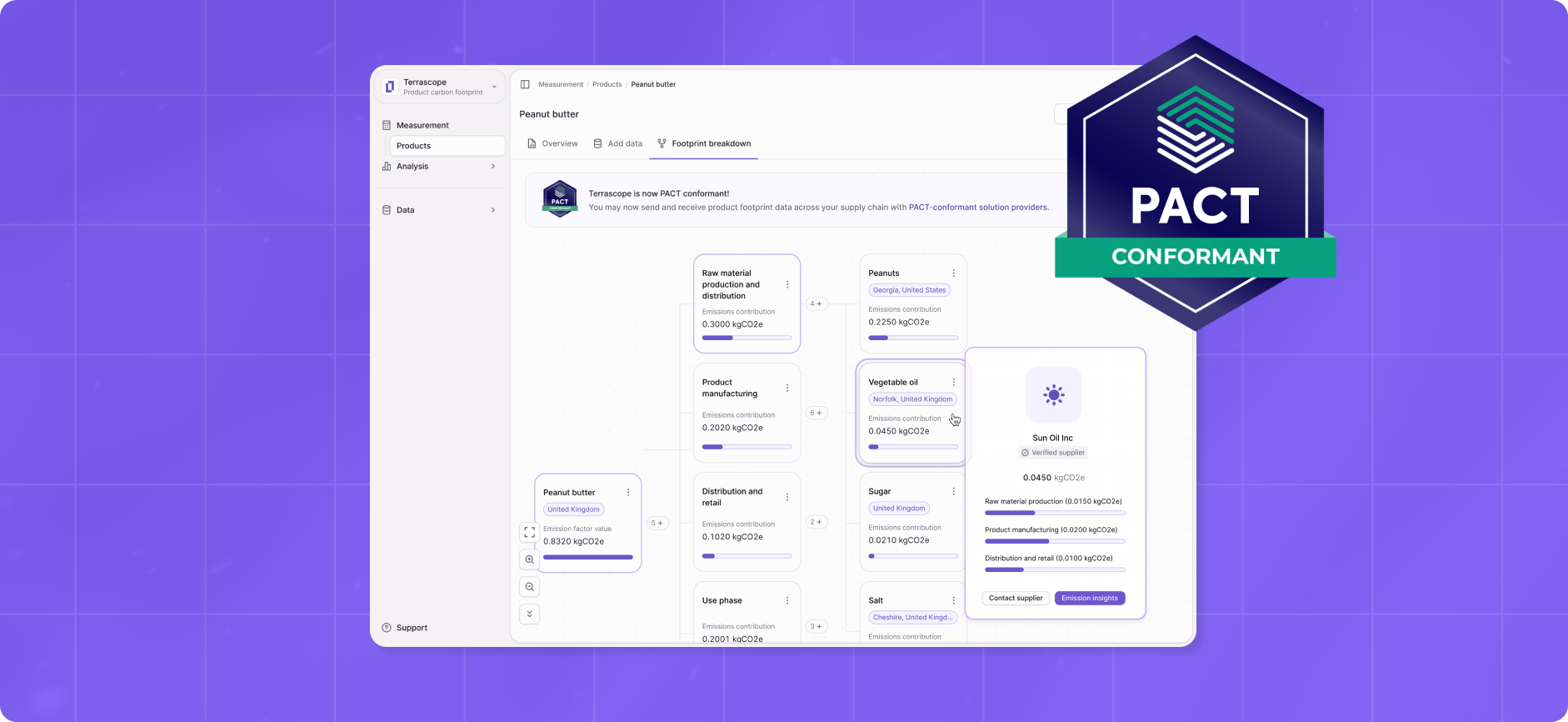Summary
- AASB S2 is currently in force for affected companies, mandating disclosure of only Scope 1 and Scope 2 emissions for now;
- The Corporations Act has been strengthened to also require disclosures to be made via a Sustainability Report;
- Terrascope can help with data ingestion and transformation to allow quick sharing with stakeholders, and also reduce the amount of black boxes for audit time.
Introduction
As part of the ambitious European Green Deal, the European Union (EU) has pledged to reduce its net greenhouse gas emissions by at least 55% by 2030, compared to 1990 levels. To achieve this goal, the EU will need to align its climate, energy, transport and taxation policies. The approval of the Corporate Sustainability Reporting Directive (CSRD) presents a significant step up in sustainability disclosures. Starting in January 2024, the new law requires companies to disclose their sustainability performance. This will enhance the transparency, comparability, and reliability of sustainability reporting across the EU, aiding investors, consumers and other stakeholders in assessing corporate sustainability. In this blog, we will explore the key aspects of the CSRD and its implications for companies and stakeholders.
Why has the EU come up with the CSRD?
The EU has long recognised the critical role that businesses play in addressing environmental, social, and governance (ESG) challenges. In order to channel investments towards recipients who can advance the EU’s green goals, investors need to access good sustainability information on investees. The existing Non-Financial Reporting Directive (NFRD) aimed to compel some major corporations to report on their sustainability performance annually. Nonetheless, investors continued to face challenges stemming from inadequate, unreliable and non-standardised data, hindering effective comparison and decision-making.
The CSRD is a response to the growing need for more robust and standardised sustainability reporting. It aims to ensure that companies provide accurate and consistent information, which can then enable meaningful progress towards net zero. The CSRD will supersede the existing Non-Financial Reporting Directive (NFRD), and enhance the NFRD’s coverage, transparency, and scope.
Differences between CSRD and NFRD
The CSRD will be a major improvement on the existing NFRD. Firstly, the coverage of companies will be expanded. Under the NFRD, large companies are required to publish information related to environmental matters, social issues and treatment of employees, respect for human rights, anti-corruption and bribery, and diversity on company boards (in terms of age, gender, educational and professional background). These reporting rules apply to large companies with over 500 employees and either more than €40M turnover or €20M total assets. They also apply to public interest entities such as listed companies, banks, and insurance companies. In total, the NFRD covers approximately 11,600 enterprises.
In contrast, the CSRD requires a broader set of companies to report on sustainability – approximately 50,000 companies in total. It will apply to large companies (listed or non-listed) that meet at least two of the following criteria:
- >250 employees
- >€40M turnover
- >€20M total assets
The CSRD covers listed companies in an EU-regulated market (including SMEs), and non-EU companies which generate a turnover of more than €150 million in the EU and fulfil any one of the two following conditions -
- At least one large or listed subsidiary in the EU OR
- At least one branch in the EU with more than €40 million in net turnover
Another key difference is the penalties for non-compliance. Countries can decide whether to impose penalties for non-compliance to the NFRD, and most countries have adopted fines. The CSRD goes further than NFRD by requiring member states to implement the following measures:
- A public declaration describing the infraction and identifying the guilty person/entity;
- A cease-and-desist order;
- Pecuniary (non-criminal monetary) penalties.
Furthermore, under the CSRD, independent third-party assurance of sustainability information will be mandatory. This requirement aims to enhance the credibility and reliability of reported data, providing greater confidence to investors and stakeholders.

Compliance with the European Sustainability Reporting Standards (ESRS) becomes mandatory
Companies will need to follow the European Sustainability Reporting Standards (ESRS) to disclose corporate sustainability information and comply with the CSRD.
The ESRS comprise both cross-cutting standards as well as topical standards. Examples of these topics include climate change, biodiversity, human rights, and supply chain management. There will be separate standards for specific sectors and for listed small and medium enterprises (SMEs) in the future.
The standards are designed to be comprehensive, concise, and adaptable to various industry sectors and organisational sizes. For every topic, the ESRS follows a four-pillar approach, similar to the approach used by the Task Force on Climate-related Financial Disclosures (TCFD) and the International Sustainability Standards Board (ISSB). As the ESRS is likely to be more robust than the TCFD, companies that follow the TCFD now will likely need to expand the nature and extent of their disclosure to comply with the ESRS.
The ESRS seeks to harmonise reporting practices within the EU. By aligning with international best practices and addressing the specific needs of the European market, the ESRS aims to facilitate cross-border comparability while ensuring the unique characteristics of the EU economy are adequately reflected in reporting. The ESRS aims to harmonise reporting practices, ensuring consistency, comparability, and relevance of sustainability information across organisations and sectors.
Focus on Climate Change
Given the urgent need to address climate change, the CSRD places significant emphasis on climate-related reporting. This focus on climate change aligns with the EU's broader sustainability agenda and its commitment to achieving climate neutrality by 2050.
Climate-related reporting under the CSRD will involve disclosing greenhouse gas emissions, energy consumption, climate-related targets, and adaptation strategies, among other things. For GHG emissions, companies have to disclose Scope 1, 2, and 3 data.
Companies that set emission reduction targets will need to disclose targets across Scope 1, 2, and 3 emissions in absolute value - either in tCO2e or as a percentage of the emissions of a base year - and in intensity value (where relevant). They will also have to mention the current base year and baseline value, updating the base year for your GHG emission reduction targets after every five-year period from 2030 onwards. They must specify target values for 2030 as well as 2050, if available.
Crucially, companies will also have to state whether the GHG emission reduction targets are science-based and compatible with limiting global warming to 1.5°C; and describe the expected decarbonisation levers and their overall quantitative contributions to adhere to their reduction targets.
This information will enable stakeholders to evaluate a company's exposure to climate risks and its efforts to transition towards a low-carbon economy. By promoting transparency and accountability in climate reporting, the CSRD aims to drive sustainable practices and support the EU's climate objectives.
Implementation
The implementation of the ESRS will be carried out in a phased manner, taking into consideration the diverse categories of companies. The initial batch of companies will be mandated to adhere to the standards for financial year 2024, with their reports being published in 2025. For listed small and medium-sized enterprises (SMEs), reporting obligations will commence from 2026, with the choice to voluntarily opt out until 2028.
Implementing the ESRS may present challenges for organisations, particularly in terms of data collection, integration of reporting systems, and alignment with existing reporting frameworks. Companies will need to assess their current reporting practices, identify gaps, and develop strategies as part of their overall decarbonisation journeys. Collaboration with stakeholders, including suppliers and customers, may be necessary to ensure the availability and accuracy of relevant data.
Conclusion
The CSRD represents a significant milestone in the EU's journey towards a more sustainable future. By providing a standardised reporting framework, the CSRD will foster greater comparability and transparency of sustainability information, especially for climate change.
The CSRD's focus on climate change underscores the EU's commitment to tackling the pressing challenges posed by global warming. By mandating climate-related reporting, the CSRD will compel companies to assess and disclose their environmental impact and take necessary steps to mitigate climate risks. It presents an opportunity for businesses to improve their sustainability performance, build trust with stakeholders, and contribute to a more resilient and responsible future.
As the CSRD enters the implementation phase, it is crucial for companies to stay informed, seek guidance, and actively engage in the reporting process. By embracing the CSRD, organisations can play a vital role in driving sustainable practices and contributing to the EU's broader sustainability goals.



